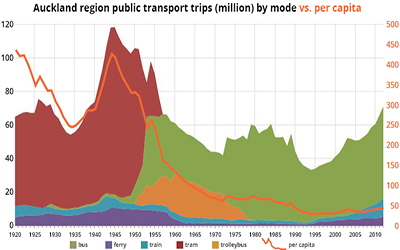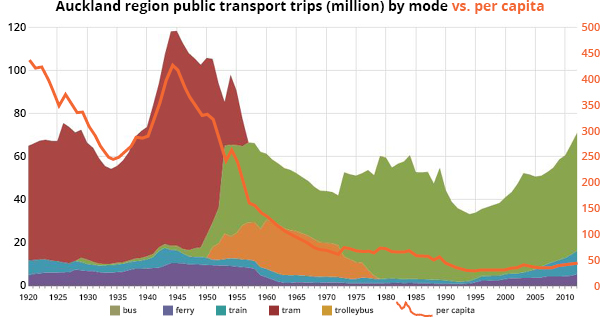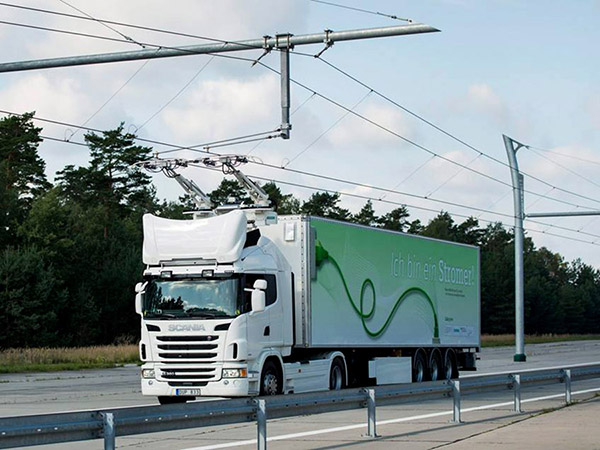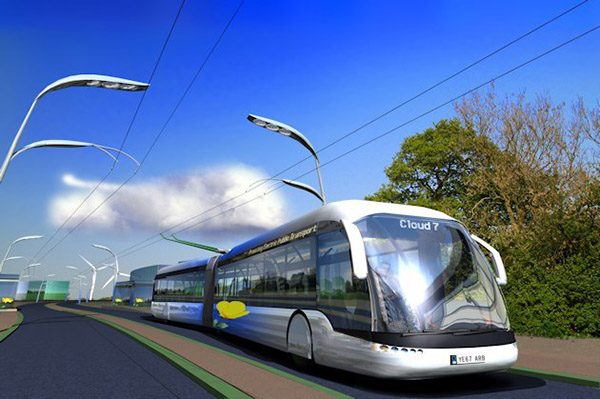With every fibre and electrified-transit solution


Per Capita Disaster: If Aucklanders were using electrified public transport at the rate they did at the end of World War II, they would be taking about 720 million trips per year, yet there is jubilance over the 90 million figure just reached. A staggering 13.4 billion kilometres were driven on Auckland region roads in 2015, a figure that is presumably still growing by about 3.3% per year. chart Greater Auckland | Mahurangi Magazine
Aucklanders once took an average of more than 400 public-transport trips per year.
In 1945, with a sixth of the population, Aucklanders were taking nearly 120 million trips, compared to today’s paltry 90 million boardings.
Not that all Aucklanders should be aspiring to make 400 journeys per year, particularly for work purposes, and particularly in rush-hour traffic. While electrified public transport is core climate action, travelling by fibre-optic cable to a virtual place of work is the zero-carbon solution available to many, most obviously to the more than 30 000 information and communications technology workers. But with three quarters of commuting trips being made by private car, and more the 94% of those single-occupant, public transport is required to rapidly ramp up to a very much larger role, regardless of how quickly resistance to digital commuting finally falls away.

Joined-Up Electrified Transport: With the technology already proven, and with a government apparently in a position to biff billions at light rail, Aotearoa could quickly lead the world in transportation electrification. Pictured is a Scania trolleytruck powered by Siemens-subsidised infrastructure near Gävle, Sweden. Although Aotearoa produces a higher percentage of its electricity zero-carbon than does Sweden, both countries will need to seriously step up—or step into, in New Zealand’s case—nuclear power production, to electrify everything that must be electrified if a survivable climate is to be salvaged. image wSensie.pl
A test of whether Warkworth’s future transport network is fit-for-purpose will be the opportunities it provides for co-working spaces handy to bus stops, or, preferably, as a seamless part of bus stations. A glaring deficiency in current park-and-ride thinking is epitomised at Albany, where the 1100-car-space busway station lacks a café or any space conducive to meeting or working, and lacks a dedicated shuttle to the nearest, barely walkable, shopping mall. While the mall does have a bus stop, the service from the busway station is erratic and can involve an unacceptable 20-minute wait.
Car centricity is humankind’s single greatest greenhouse gas emissions misstep. Battery-electric vehicles might have won the battle for the headlines but, as beguiling as they are, they are no substitute for proven solutions such as trolleybuses, which, battery-assisted, have an economy and flexibility of deployment that makes light rail look ludicrously capital-investment heavy and inflexible. The imperative for immediate, meaningful climate action should mean that busway electrification gets first bite of the billions that have suddenly been found for light rail. But any solution with bus in the name is not perceived as sufficiently sexy by vote-seeking politicians, most of whom would prefer death to be seen in a bus, and a government limousine over any form of public transport, for that matter. But of course motorists looks at the length of a double-articulated trolleybus and despair that there will be no road left for their cars, whereas the public transport user looks at the same zero-carbon solution and knows that is 200 fewer cars needing to.

Perfectly Epitomising Problem and Solution: The failure of planners and politicians to recognise a muture zero-carbon public transport solution right under their overhead-wire-distaining noses epitomises the perfect problem that is anthropogenic global warming. Aotearoa can’t get to zero-carbon if its government hasn’t the gumption, and courage, to prioritise a solution with bus in its name—trolleybuses, at half the cost of light rail. rendering Trolley
As is currently being grotesquely demonstrated by America’s alt-right, at scale, humans have the hardest time seeing themselves as the bad guy. But, when it comes to anthropogenic global warming, humanity collectively is the bad guy—only the very young and the very poor can be completely absolved of responsibility for fossil fuel use; everybody else has got at least a little avoidable carbon on their conscience. Meantime, just when nations need their governments most, to mobilise meaningful climate action, politics has degenerated into how to get elected and stay elected, by ruffling as few of the middle’s feathers as possible, by unbridled demagoguery, or by some form of populism in between—anything but take true leadership.
Generations of economics students have been sold on the self-serving baseless deceit that the market knows best. But the market is utterly incapable of the joined-up-thinking demanded by the imperative to radically reduce anthropogenic greenhouse gas emissions. The purchasing decisions of an individual employee can’t magic up the distributed working environment and electrified public transport system needed until those things exist as choices. Planning a public transport system that prioritises a survivable climate is only possible if the agencies involved are charged with that existential imperative.
Short of electing a government led by a party not still shackled to failed neoliberalism, sending in Future Mahurangi Transport Network Feedback will at least let the Supporting Growth Programme team know that some the people know they need a survivable climate.

That’s a great article Cimino, you are right on the button with most of this stuff.
There needs to be some way to get these articles into the national consciousness.
Monthly guest article in the New Zealand Herald or the other paper. Maybe a monthly column in the Listener. What about Metro?
They need to be brought to the decision-makers’ attention!